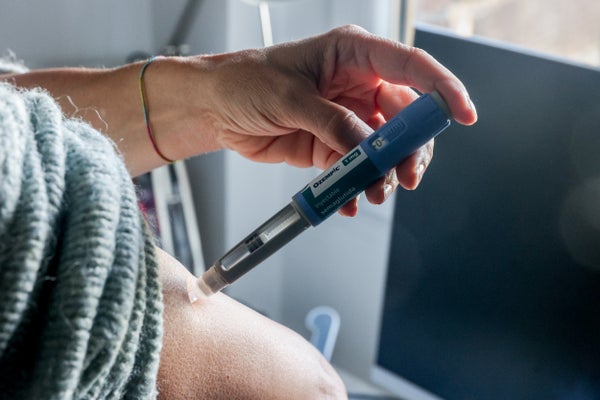Tracking Ozempic’s Nausea Side Effect to Specific Neurons May Lead to Better Drugs
The neurons that produce a sick feeling and food aversion are distinct from those that induce a feeling of fullness
A person using Ozempic on November 2, 2023, in Madrid, Spain.
Ricardo Rubio/Europa Press via Getty Images
Next-generation anti-obesity drugs such as Wegovy can melt away weight — but they can also cause intolerable nausea. Now scientists have pinpointed a brain pathway that is involved in this common side effect, raising the prospect of effective weight-loss drugs that don’t make people sick1.
The scientists found that the nausea-inducing brain circuit, which also triggers aversion to food, is separate from the circuit that helps the drugs to produce satiety, the feeling of fullness that prevents people from eating more.
“The implication is that if we can now selectively target the satiety circuits without targeting the aversion circuits, we could potentially develop better drugs with fewer side effects,” says Amber Alhadeff, a neuroscientist at the Monell Chemical Senses Center in Philadelphia, Pennsylvania, and a co-author of the study, published today in Nature.
On supporting science journalism
If you’re enjoying this article, consider supporting our award-winning journalism by subscribing. By purchasing a subscription you are helping to ensure the future of impactful stories about the discoveries and ideas shaping our world today.
Sickness and health
Drugs such as Wegovy mimic a hormone called glucagon-like peptide 1 (GLP-1), which controls blood sugar levels and acts on the brain to reduce appetite. (Wegovy and the diabetes drug Ozempic are brand names for semaglutide, which is made by Novo Nordisk, based in Bagsværd, Denmark.) Multiple regions of the brain have GLP-1 receptors, but which specific receptor populations are involved in the drugs’ effects is not fully understood.
To resolve that uncertainty, Alhadeff and her colleagues first killed neurons with GLP-1 receptors in specific regions of the brains of mice. The researchers then gave the mice a GLP-1-mimicking drug: either semaglutide or exenatide, which also has weight-loss effects.
Mice lacking the GLP-1 neurons in a region called the hindbrain ate normally. This showed that the medications’ effect had been completely blocked. But the medications still worked after the researchers killed the GLP-1 neurons in the brain region called the hypothalamus, which is known to play an important part in appetite regulation and was thought to be important for the action of GLP-1 drugs2. “We were shocked by this,” says Alhedeff. “The takeaway is that the hindbrain is really the primary site of action for the drugs.”The researchers then investigated two subregions of the hindbrain, called the area postrema (AP) and the nucleus of the solitary tract (NTS). When the scientists turned on the animals’ AP neurons, the mice exhibited nausea and food aversion and reduced their food intake. By contrast, when they turned on NTS neurons in mice, the animals cut back on their food — but showed no signs of nausea.That means that nausea is not necessary for GLP-1 drugs to suppress food intake. This is one of the key points of the study, says Martin Myers, a neuroscientist at the University of Michigan in Ann Arbor. “If there were a way to turn on just the NTS GLP-1 receptor neurons, or all other GLP-1 receptor neurons, avoiding just those in the AP, that would certainly be a much better drug,” he says. “The trick, of course, is how to do that.”
This article is reproduced with permission and was first published on July 10, 2024.













/https://tf-cmsv2-smithsonianmag-media.s3.amazonaws.com/filer_public/d1/82/d18228f6-d319-4525-bb18-78b829f0791f/mammalevolution_web.jpg)






Discussion about this post